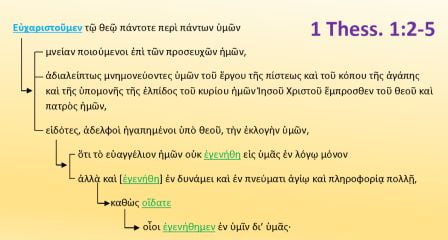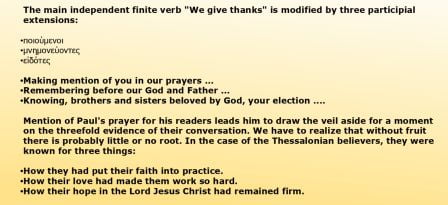(Thursday, September 20, 2018) Like most people, I think of lots of things when I’m biking (or running, or walking).
Today my random thought was: I wonder why Paul used so many agricultural metaphors in his writings. Specifically, he mentions the “fruit of the Spirit” in Galatians — a book I’ve been pondering of late, as you can probably tell. Please tell me I’m not the only person who likes to take a metaphor and translate it into non-metaphorical language. So, why did Paul say “fruit” of the Spirit when he could have said “deeds” or “works” or “expressions” or “products”? He must have thought there was an important distinction between the “works” of the flesh and the “fruit” of the Spirit, ya think? I once heard someone say that it’s the difference between the fruit on a tree in an orchard and the ornaments on a Christmas tree in your living room. The Christmas tree ornaments have no living connection to the tree. They are completely independent objects that we hang on the tree. But fruit has a vital connection to the tree. Without the life in the tree, there can be no fruit on the tree.
As I pondered this question while riding along, I thought back to the lecture I gave yesterday on what the apostle Paul says about the ministry of the Holy Spirit in the book of Galatians. It’s one thing to know the will of God. It’s another thing to actually do God’s will. And the amazing thing is that the obedience that God requires in our lives is exactly the same obedience that He enables. Because I wasn’t able to do this in my lecture yesterday due to time constraints, I want to point out here four additional metaphors Paul uses to describe how we are to live the Christian life. These are all to be found in the 5th chapter of Galatians. They are:
- Walk in the Spirit.
- Be led by the Spirit.
- Keep in step with the Spirit.
- Sow to the Spirit.
To walk in the Spirit is to live by the power that the Spirit gives us. To be led by the Spirit is to allow the Spirit to direct our lives instead of our fallen, sinful natures. To keep in step in the Spirit is a wonderful military metaphor. “Left, right, left, right,” goes the drill sergeant, and likewise we place our feet wherever the Holy Spirit is wanting us to place them. Finally, we need to sow to the Spirit if we are to bear the “fruit” of the Spirit.
So you might wonder: How do I know whether or not I am walking in, being led by, keeping in step with, and sowing to the Spirit? The Bible is clear that this does not happen automatically. As Paul says in Eph. 5:18, we have to invite the Holy Spirit of God to control our lives. I don’t know about you, but I have to do this on a daily basis at least. Every morning, before I set foot on the floor, I pray a very simple prayer: “Father, thank You so much for this new day. It belongs to You. My goal this day is to please You. Lord Jesus, You are my King and my Master. My goal this day is to serve You. And Holy Spirit, please fill me with Your power and presence so that I may be enabled to please the Father and serve the Lord Christ.” Then I begin to proceed through my day. I’m constantly asking, “Lord, what would you have me do today? What shall I write today, if anything? How shall I serve you today? What emails and text messages should I answer and when? Who needs a phone call of encouragement from me today? What exercises shall I do today to maintain this temple You’ve given me? Where and for how long shall I meditate on Your word? Shall I cut grass today or tomorrow?”
As for prayer, for me the key verse is Eph. 5:18: “praying at all times in the Spirit.” I don’t want prayer to be a do-it-yourself activity. I want to pray when the Spirit is prompting me to pray, all throughout the day. Plus, keep in mind that prayer is much more than spoken communication. Prayer is also communion — a moment by moment, step by step, relationship with God. Not only do I pray when I get up in the morning, but I pray while biking or running, while doing the kitchen dishes, while standing in the grocery store line, while taking a shower. I’m not very good at compartmentalizing: This is spiritual, and this isn’t. Sometimes my prayer is a quick “Thanks.” Often it’s a desperate “Help me.” Prayer, for me, is like talking to my best friend. It’s spontaneous. While out biking today, about all I could think about was how thankful I am to God to be able to be outdoors doing what I love to do. Sometimes I pray with groanings that can’t be expressed in words, as I did for a long time last night. It’s at these moments that the Holy Spirit, we are told, “helps us in our weakness…. And the Father who knows our hearts knows what the Spirit is saying, for the Spirit pleads for us believers in harmony with God’s will” (Rom. 8:26-27). Finally, more often than I’d like, I find myself asking forgiveness of the One I love. That’s why, when I wake up in the morning, the first thought on my mind is, “Holy Spirit, please help me. Fill me with Yourself so that I may walk in You, be led by You, keep in step with You, and sow to You.”
My friend, whatever it is you are relying on today other than the Spirit for help in making progress in holiness, for God’s sake, get rid of it. Amputate it as you would a gangrene limb. He accepts you as you are. And the obedience that He requires of you this day, He will also enable. You can count on it.
Well, sorry folks, but my thoughts are totally random and scrambled after I work out. I think of a lot of things while exercising, and it just so happened that today you had to bear the brunt of my latest cogitating!
(From Dave Black Online. Used by permission. David Alan Black is author of a number of books, many of them from Energion Publications, including The Jesus Paradigm, Seven Marks of a New Testament Church, and Running My Race: Reflections on Life, Loss, Aging, and Forty Years of Teaching. This post used by permission.)






